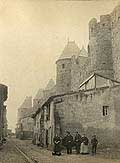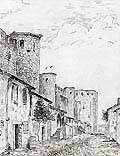As the restoration began, the ancient walls had been entirely taken over by a settlement built right along the fortifications.
"Thus today, these walls are at the mercy of the inhabitants who damage them every day either by removing materials for their needs or by leaning "parasite" buildings against the inner walls. [...] Many of these owners have set cupboards and even cellars into the thick walls, others have taken possession of the ground floors of the towers and made them into rubbish dumps or shops [...]. The removal of these hovels could be considered a health measure." (Viollet-le-Duc, Archives du Patrimoine, 284)
Clearing these houses from the lists, which began under Viollet-le-Duc, went on for more than half a century. The restoration of the towers was often carried out without touching the dwellings beneath them.
At the beginning of the XXth Century the lists had been more or less cleared. Many of the inhabitants had left the city and others had taken the opportunity to settle within the second walls. From being barely tolerated on its outskirts they became the legitimate occupants, and, for them, the restoration was the beginning of a new era. The establishment of the community merged with the birth of the monument. And so Viollet-le-Duc, who had turned the inhabitants of the lists out, in so doing, had given them the opportunity to come back into the fortified town. He can thus be seen as one of the founders of the modern city's identity.




